What is Customer Health Score: 6 Key Metrics
Customer health scores predict how likely a customer is to churn, helping you prioritize upsell opportunities. The scores combine usage data and other metrics to give a rating for customers

Customer health scores predict how likely a customer is to churn, helping you prioritize upsell opportunities. The scores combine usage data and other metrics to give a rating for customers

How well do you know your customers’ health and wellness habits? Do you have a system in place to track and monitor their progress towards a healthier lifestyle?
Businesses are increasingly focusing on ways to support their customers in achieving their health goals. One tool that has gained popularity recently is the customer health score. Having a client health score can help businesses better understand their customers’ needs and preferences. 30% of companies adjust their consumer health scores based on changing business conditions.
Businesses get to easily tailor their offerings to support their health and wellness goals. The article explores the importance of customer health and how businesses can use it to improve customer satisfaction.
A customer health score is a metric that predicts how likely your customers are to stick around or leave your business. Think of it like a medical checkup for your customer relationships. It combines various data points about customer behavior and engagement to give you a single number that tells you if each customer is thriving or at risk.
The system tracks customer actions like product usage frequency and support ticket volume then weighs these factors against historical patterns. When customers show declining engagement or increased complaints, the score drops automatically.
The beauty of customer health scoring lies in its simplicity! Instead of drowning in spreadsheets of customer data, you get one clear signal that guides your daily decisions. It transforms gut feelings about customer relationships into actionable insights your entire team can understand and act upon.
Key objectives:
Below are the pivotal benefits of integrating a customer health score into your business strategy and how it can pave the way for sustainable success.
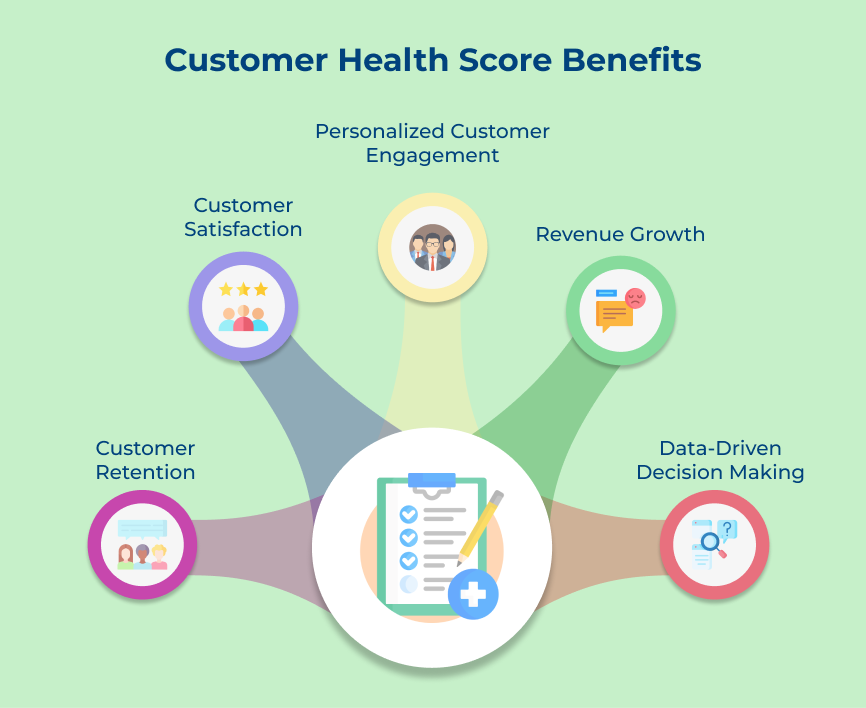
One of the primary benefits of a customer health score is its ability to predict customer churn. Businesses can address customer issues and prevent them from leaving by identifying early warning signs of dissatisfaction. In our recommendation, it is vital for businesses as almost 65% of the business comes from repeat customers.
Monitoring client health scores can also help businesses gauge overall customer satisfaction levels. Tracking metrics such as product usage, support interactions and feedback can identify areas for improvement. It can lead to higher customer satisfaction and loyalty over time.
Consumer health scores can enable businesses to tailor their engagement strategies based on individual needs. Segmenting customers according to their health score can help deliver targeted messages and resources that are relevant to each customer.
Businesses can identify upsell and cross-sell opportunities by leveraging customer health score data that can help increase revenue. Understanding which customers are most engaged can enable companies to recommend additional offerings. It can contribute to overall revenue growth and business success.
Health score provides businesses with valuable data and insights that can guide strategic decision-making. Analyzing trends in customer behavior can identify opportunities for innovation and expansion. The data-driven approach can help businesses stay competitive and make informed choices that drive sustainable growth.
The following are the principal types of customer health scores that can be scaled to lead to a proactive customer success strategy.
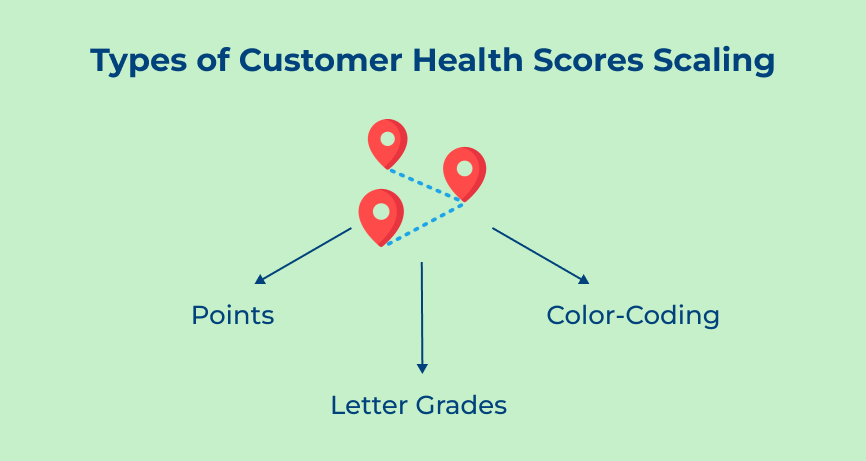
1. Points
One way to measure customer health scores is on a scale of points, typically ranging from 1 to 100. The numerical scale allows businesses to assign specific values to different aspects of customer health, such as engagement and loyalty. Businesses can easily track customer health over time by calculating the overall score based on individual metrics.
2. Letter Grades
Another scale that businesses can use to measure client health scores is letter grades, such as A, B, C, or D. The grading system simplifies the assessment process by categorizing customers into different levels of health based on predetermined criteria. Let’s assume that customers who regularly engage with the brand and make repeat purchases may receive an A grade. Customers who have lapsed in their interactions may receive a lower grade.
3. Color-coding
Colour coding is another effective way to indicate health scores, using colours such as green, yellow and red to represent good, average, or poor health. The visual representation allows businesses to quickly identify customers who may need extra support. It can help easily prioritize their efforts and focus on improving relationships with at-risk customers.
Let us now go through the essential customer health score metrics that will keep your business thriving and your customers happy.
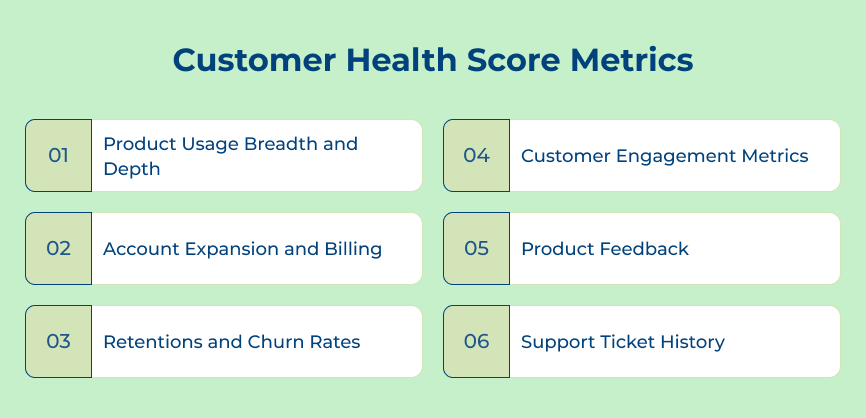
Product usage breadth and depth are essential components of tracking customer health scores. The metric evaluates how extensively and frequently a customer uses the company’s solution. It looks at both the features the customer utilizes as well as the intensity of their usage. Customers who engage with a wider range of features and use them frequently are likely to be more satisfied.
Account expansion and billing metrics are also crucial in assessing health scores. The metrics track the customer’s propensity to grow their account by adding more services. Metrics like revenue per user inform a customer relationship’s financial health. Account expansion and higher revenue from customers signal a healthy relationship.
Retention and churn rates are key indicators of client health scores, as they reflect the customer’s loyalty to the product or service. Retention rate measures the percentage of customers who continue to use the product or service over a specific period. A high retention rate signifies strong customer relationships and satisfaction.
Customer engagement metrics play a crucial role in determining the health of customer relationships. It includes metrics such as customer satisfaction ratings, frequency of interactions with the company and engagement with campaigns. Businesses can analyze metrics to gauge customer satisfaction and loyalty.
Product feedback is another important metric used to track customer health scores. Businesses can gather feedback to understand how their products are perceived in the market. It can help businesses make improvements to their products to better meet customer needs.
Support ticket history is a key metric that can provide insights into the health of customer relationships. Analyzing support tickets can reveal recurring issues impacting satisfaction. The information can help businesses enhance their services and address concerns.
Here’s a comprehensive guide to understanding what goes into these scores and how to calculate them effectively
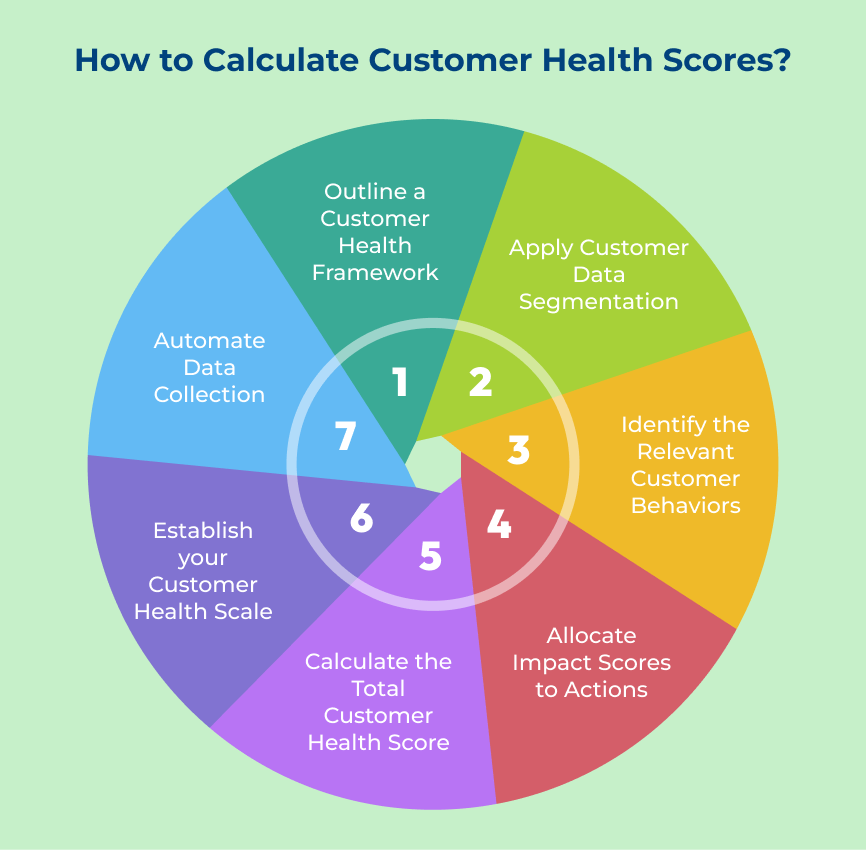
When it comes to measuring the success and satisfaction of your customers, having a customer health framework in place is essential. The framework allows businesses to analyze key customer metrics to calculate customer health scores. Health scores indicate customer well-being and the likelihood of renewal.
Let’s consider that a customer has low product usage rates, minimal engagement with your company and low satisfaction scores. The health score may indicate a high risk of churn. Customers with high product usage, frequent engagement and high satisfaction levels may be considered healthy.
Pro tips:
Customer data segmentation is an essential step in calculating customer health scores. Categorizing customers based on their behaviors, preferences and interactions with your business can help effectively measure their satisfaction.
Let’s assume that by segmenting customers into categories such as active users and dormant users, you can assess which group is most engaged with your offerings. It can also give an idea of which group may need additional attention to prevent churn.
Pro tips:
Customer health scores are a crucial tool for businesses to gauge the satisfaction and loyalty of their customers. One important step in calculating health scores is identifying the relevant customer behaviours. Identifying customer behaviours involves pinpointing the interactions that indicate a customer’s engagement with your offerings.
Let’s consider that customer behaviours in a software company could include frequency of product usage, completion of onboarding tasks and feedback submission. Tracking behaviours quantifies them and aggregates them to determine the customer’s health score.
Pro tips:
Allocating impact scores to actions is a crucial step in the process of calculating customer scores. The step involves assigning numerical values to different actions that indicate the level of impact they have on a customer’s satisfaction with your offerings.
Let’s assume that if a customer completes a tutorial, they may receive an impact score of 5. If they provide positive feedback, they may receive a score of 10. The impact scores can then be used to calculate an overall consumer health score. It provides valuable insights into the health of the customer relationship and the likelihood of retention.
Pro tips:
Calculating the total customer health score is a crucial step in assessing the overall satisfaction and loyalty of your customers. It provides insights into the health of your customer base and can help guide strategic decisions to improve relationships.
The formula to calculate the total consumer health score typically involves assigning numerical values to different aspects of the experience. It includes satisfaction levels, engagement frequency and likelihood to recommend the offering. The values are then weighted accordingly to reflect their importance in determining overall customer health.

Add up the weighted scores for each aspect of the customer experience to calculate the total client health score. Let’s consider that satisfaction is weighted at 40%, engagement at 30% and likelihood to recommend at 30. You would multiply each score by its respective weight and sum the results.
Example:
Satisfaction score: 8
Engagement score: 7
Likelihood to recommend score: 9
Total customer health score = (8*0.4) + (7*0.3) + (9*0.3) = 3.2 + 2.1 + 2.7 = 8
Pro tips:
Establishing your customer health scale is a crucial step in calculating consumer health scores. It allows you to measure the satisfaction and engagement levels of your customers. Assigning a numerical value to each customer can help track the health of your customer base.
Let’s assume that a software company may use a numerical scale to measure customer health based on feature utilization and customer support interactions. A retail business might use a color-coded scale. It can help the business to assess customer health through purchase frequency and average order value.
Pro tips:
Automating data collection and continuously improving are essential steps in calculating client health scores. Automating data collection can gather valuable information about customer interactions, behaviors and feedback in real time. The data is crucial for determining the overall health of a customer relationship and identifying areas for improvement.
Continuous improvement ensures that health scores are accurate, allowing businesses to make informed decisions regarding retention and satisfaction. Let’s consider that a software company may use automated data collection to track customer usage patterns and feedback. It enables them to identify at-risk customers and take proactive measures to retain them.
Pro tips:
Following are the customer health score examples that can transform your understanding of client satisfaction and help you maintain a proactive, rather than reactive, stance in your customer management strategy.
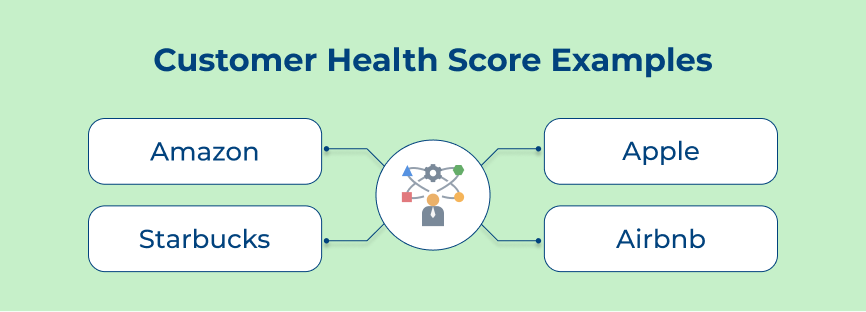
1. Amazon
As one of the largest e-commerce retailers in the world, Amazon places a strong emphasis on measuring customer health scores. They track metrics such as repeat purchase rate, order frequency and feedback to gauge the satisfaction of customers. Amazon can implement strategies to enhance the experience by analyzing the data.
2. Apple
Apple is known for its loyal customer base and is in part due to its focus on measuring client health scores. They track product satisfaction, customer support interactions and Net Promoter Score to evaluate customer sentiment. Apple can address any issues by monitoring the metrics that may arise and ensuring that their customers remain satisfied.
3. Starbucks
Starbucks is another example of a brand that prioritizes measuring customer health scores. They utilize customer loyalty, average spend per visit and feedback to assess client health. Starbucks can tailor their strategies by monitoring the metrics to meet the needs of its customers.
4. Airbnb
As a leading hospitality platform, Airbnb places a strong emphasis on measuring consumer health scores to drive business growth. They track metrics such as booking frequency, host ratings and guest reviews to evaluate the overall satisfaction. Airbnb can identify trends by analyzing the data, which helps them improve the customer experience.
Check out the strategies to elevate your customer health score, ensuring not just customer satisfaction, but lasting customer relationships.
[av_image src=’https://veemo.io/wp-content/uploads/2024/05/How-to-Improve-Customer-Health-Score_.png’ attachment=’10795′ attachment_size=’full’ copyright=” caption=” image_size=’no scaling’ styling=” box_shadow=’none’ box_shadow_width=’10’ box_shadow_co
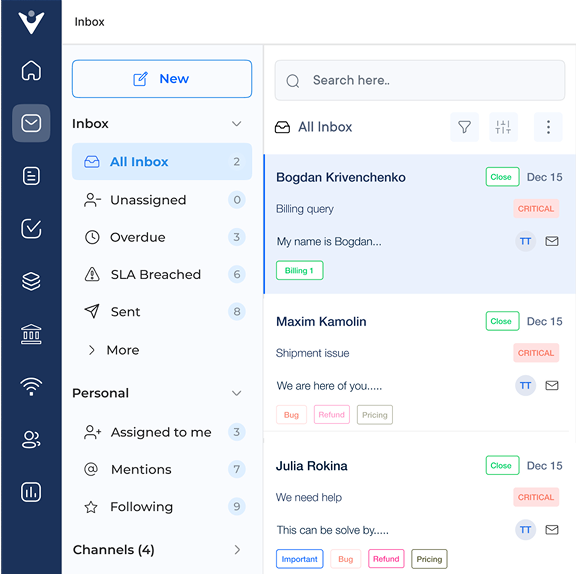
Market better, sell faster and support smarter with Veemo’s Conversation Customer Engagement suite of products.
Unify all your customer data in one platform to deliver contextual responses. Get a 360 degree view of the customer lifecycle without switching tools.
Connect with the tools you love to reduce manual activities and sync your business workflows for a seamless experience.
 https://veemo.io/wp-content/uploads/2025/12/internal-emails.png
1257
2400
indrasish5342@gmail.com
https://veemo.io/wp-content/uploads/2024/11/veemo.svg
indrasish5342@gmail.com2025-11-28 07:28:592026-01-08 07:31:55How to Write Internal Emails? Types, Best Practices & Tips
https://veemo.io/wp-content/uploads/2025/12/internal-emails.png
1257
2400
indrasish5342@gmail.com
https://veemo.io/wp-content/uploads/2024/11/veemo.svg
indrasish5342@gmail.com2025-11-28 07:28:592026-01-08 07:31:55How to Write Internal Emails? Types, Best Practices & Tips https://veemo.io/wp-content/uploads/2025/12/Crisis-Management-Plan.png
1257
2400
indrasish5342@gmail.com
https://veemo.io/wp-content/uploads/2024/11/veemo.svg
indrasish5342@gmail.com2025-11-25 07:19:072026-01-08 07:24:30Crisis Management Plan Guide: Stages, Importance & Examples
https://veemo.io/wp-content/uploads/2025/12/Crisis-Management-Plan.png
1257
2400
indrasish5342@gmail.com
https://veemo.io/wp-content/uploads/2024/11/veemo.svg
indrasish5342@gmail.com2025-11-25 07:19:072026-01-08 07:24:30Crisis Management Plan Guide: Stages, Importance & Examples https://veemo.io/wp-content/uploads/2024/12/customer-service-response-time.png
1256
2400
indrasish5342@gmail.com
https://veemo.io/wp-content/uploads/2024/11/veemo.svg
indrasish5342@gmail.com2025-10-17 10:51:142025-12-15 05:49:239 Effective Tips to Reduce Customer Service Response Time
https://veemo.io/wp-content/uploads/2024/12/customer-service-response-time.png
1256
2400
indrasish5342@gmail.com
https://veemo.io/wp-content/uploads/2024/11/veemo.svg
indrasish5342@gmail.com2025-10-17 10:51:142025-12-15 05:49:239 Effective Tips to Reduce Customer Service Response TimeGrow Customer Relationships and stronger team collaboration with our range of products across the Conversational Engagement Suite.

 7 Proven & Effective Ways to Reduce Shopping Cart Abandonment
Scroll to top
7 Proven & Effective Ways to Reduce Shopping Cart Abandonment
Scroll to top